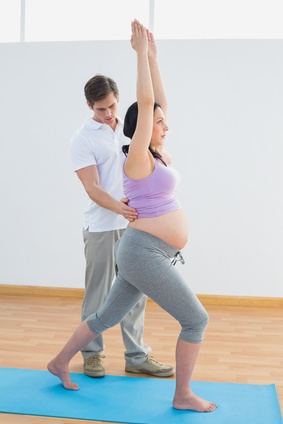Say good-bye to the myth of the “delicate” condition and hello to pregnancy in the 21st Century!
Current research continues to show that women can safely exercise and maintain their fitness level during the perinatal period. The mom who laces up her sneakers instead of heading to the couch will be rewarded with a healthier pregnancy and a healthier baby.
 Pregnancy is a time of excitement, uncertainties, fears, and many profound physical and emotional changes. This “season in life” affords mom a wonderful opportunity to adopt a healthier lifestyle. Starting an exercise program during pregnancy is a great way to begin and continue this healthier lifestyle for herself and subsequently for her child. With obesity on the rise in the US, it is important for everyone to increase their current level of physical activity. This is especially important for pregnant women as the results of obesity and excessive weight gain have been shown to be detrimental to both mom and baby long term.
Pregnancy is a time of excitement, uncertainties, fears, and many profound physical and emotional changes. This “season in life” affords mom a wonderful opportunity to adopt a healthier lifestyle. Starting an exercise program during pregnancy is a great way to begin and continue this healthier lifestyle for herself and subsequently for her child. With obesity on the rise in the US, it is important for everyone to increase their current level of physical activity. This is especially important for pregnant women as the results of obesity and excessive weight gain have been shown to be detrimental to both mom and baby long term.
A Historical Perspective on Prenatal Exercise Guidelines
Moms today are inundated with information regarding pregnancy and exercise. Unfortunately, a great deal of this information is outdated. It is important for women to have a working knowledge of the most current guidelines so that they can make intelligent choices regarding their exercise programs. For many years, pregnant women were advised to “take it easy” during pregnancy. Mom was advised to rest and gain weight in order to ensure a healthy pregnancy. In the 1950’s women were “allowed” to walk a mile a day for exercise and this mile was preferably “broken up” into smaller segments. The American Congress of Obstetrics and Gynecology (ACOG) issued the first formal guidelines for perinatal exercise in 1985 (1). These guidelines were highly restrictive as they were not based on extensive research and were designed for the majority of pregnant women without regard to pre-pregnancy fitness levels. Four of the original guidelines are highlighted below:
- Mom should exercise at a heart rate <140 bpm.
- Strenuous exercise should not exceed 15 minutes
- Maternal core temperature should not exceed 38 degrees C
- No supine exercise after the first trimester
A great deal of research involving both sedentary and trained subjects was published
after the release of the 1985 guidelines. This prompted ACOG to publish a revision of the original guidelines in 1994 which lifted specific limitations for prenatal exercise (2). ACOG said, “There are no data in humans to indicate that pregnant women should limit exercise intensity and lower target heart rate because of adverse effects.” In this revision, there was no mention of the 140 bpm maximal heart rate or an exercise limit of fifteen minutes. Women were advised to use the “talk test” and “perceived exertion” as ways to measure exercise intensity. We were making progress! Although the 1994 guidelines were a refreshing change in the right direction for ACOG, they still did not address the pregnant athlete. In 2002, ACOG published “Exercise During Pregnancy and the Postpartum Period: ACOG Committee Opinion 267” (3). In this publication, which was reaffirmed in 2009, ACOG recognized that “in the absence of contraindications, pregnant women should be encouraged to engage in regular, moderate intensity physical activity to continue to derive health benefits during their pregnancy as they did prior to pregnancy.” This revision focused more on the athlete as well and was the first formal recommendation by an American physician group to include prenatal exercise. The major points of the 2002 update include:
- Previously sedentary women and those with any medical or obstetrical problems should obtain medical clearance before embarking on an exercise program; NO PRENATAL CLEARANCE, NO EXERCISE, NO EXCEPTION.
- Thirty minutes or more of moderate exercise daily, or on most days of the week is recommended. This brought the exercise guideline for pregnancy more in line with the ACSM guidelines for the general population.
- Competitive and recreational athletes with routine pregnancies can remain active, “listen to their bodies” and modify their exercise routines if medical necessity arises.
- Physically active women with a history of or risk for preterm labor or fetal growth restriction should reduce their activity in the second and third trimesters.
In 2006, the “ACSM Roundtable Consensus Statement: Impact of Physical Activity During Pregnancy and Postpartum on Chronic Disease Risk” was published (4). This report, based on an analysis of the most current research by a panel of scientific and clinical experts, supported the safety and long term benefits of prenatal and postpartum exercise for both mom and baby. Some of the benefits highlighted in this report and other studies show that exercise:
- Reduces the risk of preeclampsia (a condition marked by high blood pressure, protein in the urine and marked fluid retention in the mom which can lead to serious maternal and fetal complications).
- Treats or prevents gestational diabetes, the diabetes of pregnancy. For some women exercise alone may stabilize blood sugar. Moms with gestational diabetes are more prone to Type II diabetes later in life.
- Helps manage or alleviate pregnancy related musculoskeletal issues. Exercise may help with low back pain, urinary incontinence, abdominal muscle and joint and muscle issues.
- Links breastfeeding and postpartum weight loss. Weight loss can occur with moderate exercise and caloric restriction without affecting the quantity and quality of breast milk or infant growth.
- Positively impacts mood and mental health. Exercise is a “mood elevator.” It reduces stress, fatigue, anxiety and improves self-image.
- Baby’s health and development: The panel advised that beginning or continuing a prenatal exercise program had both short and long term positive effects.
 The most recent guidelines for prenatal exercise were included in the 2008 US Dept. of Health and Human Services Physical Activity Guidelines (5). Women who are not currently active should strive for at least 150 minutes of moderate intensity cardiovascular activity per week. This translates to 30 minutes of exercise 5 days a week, very similar to the ACOG guideline. They recommend that those women who are currently active may continue their normal routine providing there is an open line of communication with their healthcare providers
The most recent guidelines for prenatal exercise were included in the 2008 US Dept. of Health and Human Services Physical Activity Guidelines (5). Women who are not currently active should strive for at least 150 minutes of moderate intensity cardiovascular activity per week. This translates to 30 minutes of exercise 5 days a week, very similar to the ACOG guideline. They recommend that those women who are currently active may continue their normal routine providing there is an open line of communication with their healthcare providers
The latest research continues to showcase the benefits of prenatal exercise. A 2013 review of the international evidence reinforced the fact that women who engage in prenatal exercise have a decreased risk of developing gestational diabetes and other hypertensive disorders during their pregnancies. They are also less likely to deliver big babies (> 9 pounds). Other studies suggest that babies born to active moms are lighter and leaner at 1 and 5 years of age (6). Additional research has supported these findings and has extended the benefits to older children (8-10 year olds) (7). This is quite significant considering the fact that childhood obesity is on the rise. We now have exciting evidence that the in utero environment of exercising mothers may provide long term effects for their offspring with regards to bodyweight and body fat. Prenatal exercise may also boost babies’ brain activity. Canadian research has shown that babies of exercising moms had greater brain activity 8 – 12 days after they were born, as evidenced by an increased ability to process repeated sounds (8). This was the first study to link prenatal exercise with babies’ brain development.
In 2015, ACOG released two new publications, “Obesity in Pregnancy,” Bulletin Number 156 (9) and “Physical Activity and Exercise During Pregnancy and the Postpartum Period,” Committee Opinion Number 650 (10). Both publications emphasize the need for regular exercise to prevent or combat excess weight gain and /or obesity in the perinatal population. Greater than half of the women of childbearing age in the US are overweight or obese. Obesity in pregnancy is associated with significant risks for both mother and baby. Bulletin 156 authors wrote, “Optimal control of obesity begins before conception. Weight loss before pregnancy, achieved by surgical or nonsurgical methods, has been shown to the most effective intervention to improve other health problems.” The updated Bulletin 156 recommendations include:
- Behavioral interventions that utilize both diet and exercise can improve postpartum weight loss better than exercise alone
- BMI should be calculated at the first prenatal visit and used to counsel women on diet and exercise utilizing the Institute of Medicine Guidelines for prenatal weight gain
- Small preconception weight losses in obese patients can improve pregnancy outcome
- Losing weight between pregnancies in obese patients may decrease the risk for a large-for-gestational-age baby in a subsequent pregnancy
 Pregnancy is an ideal time for maintaining or adopting a healthy lifestyle. Recommendations from ACOG Committee Opinion Number 650, “Physical Activity and Exercise During Pregnancy and the Postpartum Period” include:
Pregnancy is an ideal time for maintaining or adopting a healthy lifestyle. Recommendations from ACOG Committee Opinion Number 650, “Physical Activity and Exercise During Pregnancy and the Postpartum Period” include:
- Physical activity in pregnancy has minimal risks and has been shown to benefit most women, although some modification to exercise routines may be necessary because of normal anatomic and physiologic changes and fetal requirements.
- A thorough clinical evaluation should be conducted before recommending an exercise program to ensure that a patient does not have a medical reason to avoid exercise.
- Women with uncomplicated pregnancies should be encouraged to engage in aerobic and strength-conditioning exercises before, during, and after pregnancy.
- OB-GYN’s and other obstetric care providers should carefully evaluate women with medical or obstetric complications before making recommendations on physical activity participation during pregnancy. Although frequently prescribed, bed rest is only rarely indicated and, in most cases, allowing ambulation should be considered.
- Regular physical activity during pregnancy improves or maintains physical fitness, helps with weight management, reduces the risk of gestational diabetes in obese women, and enhances psychological well-being.
- 20-30 minutes of moderate intensity exercise per day, on most or all days, is recommended.
- Exercise intensity should be monitored by RPE and the “talk test.” Suggested RPE is 13-14 on a 6-20 scale.
- Women are encouraged to stay well hydrated, avoid long periods of lying supine and cease exercise if they have any warning signs (see below).
- Women who were sedentary before pregnancy should gradually progress their exercise programming
- Women who were regular exercisers prior to pregnancy and who have uncomplicated, healthy pregnancies should be able to engage in high-intensity exercise programs, such as jogging and aerobics, with no adverse effects. High-intensity or prolonged exercise in excess of 45 minutes can lead to hypoglycemia; therefore, adequate caloric intake before exercise, or limiting the exercise session, is essential to minimize any risk.\Contact sports, activities with a high risk of falling, scuba diving, sky diving and “hot yoga” are not recommended
Warning Signs and Symptoms to Discontinue Exercise (11)
If a woman experiences any of the following, she should cease exercise and contact her health care provider as soon as possible:
- Vaginal bleeding or fluid leakage
- Shortness of breath prior to exertion
- Pelvic pressure or cramps
- Dizziness
- Headache or any vision problem
- Pain of any kind
- Uterine contractions
- Muscle weakness
- Calf pain or swelling
- Preterm labor
- Decreased fetal movement
- Chest pain
- Temperature extremes (hot or cold; clammy)
- Nausea / Vomiting
As a result of almost 30 years of research showing the benefits of prenatal exercise, we have seen a substantial increase in the number of motivated personal trainers who are certified to work with this very special population. No two pregnancies are the same and no two prenatal fitness programs should be the same. Trainers certified in perinatal fitness and wellness possess the knowledge and skills to design and implement individualized programs to help mom prepare for the “marathon of labor” and the “tasks of mothering” after the baby is born.
Join Sheila for her upcoming webinar:
Sheila Watkins is a perinatal fitness specialist with over 25 years of experience training 2500+ pregnant and new moms, and educating hundreds of fitness instructors, health professionals, and childbirth educators on the rapidly changing field of perinatal fitness. She is the creator of Healthy Moms® Fitness Programs to provide safe and effective group exercise classes and personal training for new and expectant moms, as well as education and training in the field of perinatal exercise for fitness professionals, childbirth educators and other health professionals.
References
- ACOG. The ACOG Guidelines for Exercise During Pregnancy and Postpartum; Home Exercise Programs, 1985.
- ACOG. Exercise During Pregnancy and the Postpartum Period. ACOG Technical Bulletin, No.189, February 1994.
- ACOG. Exercise During Pregnancy and the Postpartum Period, ACOG Committee Opinion, No. 267, Washington, DC: ACOG, January 2002 (reaffirmed in 2009).
- Pivarnik, J. et al. American College of Sports Medicine Roundtable Consensus Statement, June 2006.
- http://www.cdc.gov/physicalactivity/everyone/guidelines/pregnancy.html
- Mudd LM, Owe KM, Mottola MF, Pivarnik JM. Health benefits of physical activity during pregnancy: an International Perspective Med Sci Sports Exerc. 2013 Feb;45(2):268-77.
- Pivarnik. J. and Kuffel, E. ACSM Sports Medicine Bulletin; Active Voice: More Maternal Physical Activity May Lead to Leaner Pre-Adolescent Children; June 20, 2010.
- http://www.nouvelles.umontreal.ca/udem-news/news/2013-exercise-during-pregnancy-gives-newborn-brain-development-a-head-start.html
- ACOG. Obesity in Pregnancy. ACOG Practice Bulletin, No.156, December, 2015.
- ACOG. Exercise During Pregnancy and the Postpartum Period, ACOG Committee Opinion, No. 650, December 2015
- Watkins, Sheila S. “Healthy Moms@ Perinatal Fitness Instructor Training Manual.” 2013.


